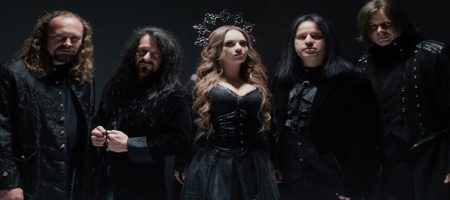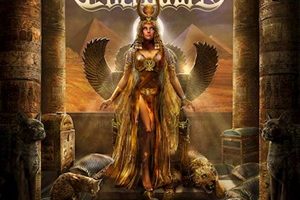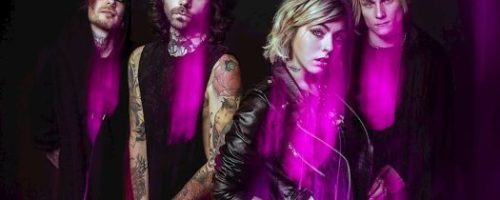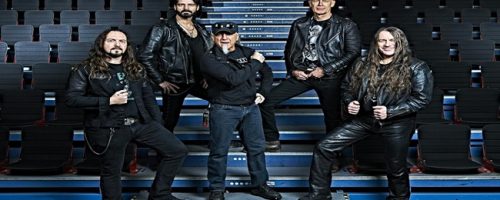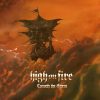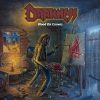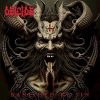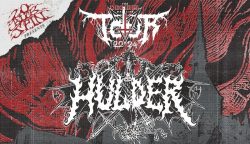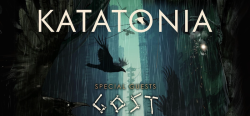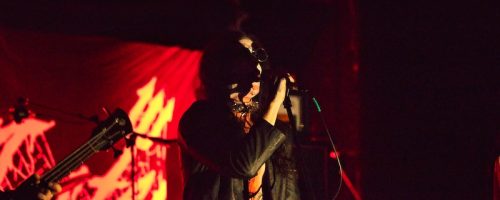Midnight Eternal – Beauty Within Harmony
Monday, 18th April 2016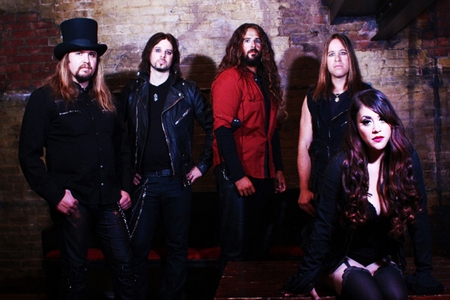
Symphonic metal can be a difficult genre to establish oneself – especially in the United States, where to many non-believers the metal genre is just a bunch of screams, growls, and loud noise. The truth resides far from this typical characterization – as layers of sonic elements converge to create a totality that can be beautiful one moment, cinematic and dark the next – while melody, harmony, and orchestration all combine to play their part in a grandiose aural/visual spectacle.
Hailing from various parts of New York City and New Jersey, Midnight Eternal quickly moved from self-releasing their debut demo to signing with Inner Wound and releasing their self-titled full-length in a scant two years. Incorporating a lot of power and neo-classical elements to add to the natural symphonic proclivities, the band can one minute sound very mysterious and powerful a la Kamelot or Epica, but then be very much melody and harmony driven a la Within Temptation or Nightwish.
Reaching out to vocalist Raine Hilai, we were able to discuss a lot about the history of the group, her introduction to the symphonic metal genre with the mighty Nightwish, and also her thoughts on the dreaded ‘female-fronted’ tag that Midnight Eternal may receive from certain category happy parties. Before you know it, one of these US acts could ascend to the level of the European headliners if all the right elements and push/ promotion fall into place – and this act easily could be the one.
Dead Rhetoric: Can you give us some early memories surrounding your music development in childhood as well as how you got into heavy metal and wanted to become a singer?
Raine Hilai: Sure. I come from a musical family, and I’ve been singing since a very, very young age. I was about five years old when I decided I wanted to become a professional singer. Music has always been a part of my life, there has not really been a time I could pinpoint where it was just a pastime. I started taking professional voice lessons at the age of ten, I studied as a classically trained soprano, I studied musical theater and pop/rock – music has always been a huge part of my life, whether it’s listening to music or playing.
I started discovering metal when I was about 14, pretty late in high school – it was when I heard Nightwish that I decided that metal was the genre that I definitely wanted to sing as a career.
Dead Rhetoric: Midnight Eternal started in March of 2014 with guitarist Richard Fischer and keyboardist Boris Zaks. At what point did they approach you to join, and when did things transform from project status to a full-fledged active band?
Hilai: They started the project about a month before they approached me. At the point they got in touch with me they had everything already recorded. Those first two songs we released “When Love and Faith Collide” and “Masquerade of Lies”, when they reached out to me all of the instruments were already recorded. I came on board and it was pretty much almost instantaneous, it was when those two songs were recorded and we heard the final results that we knew that we had something special and we knew we wanted to make this a full-time band, rather than just a side-project. We had all the elements still there. Boris and Richard are very much a part of Midnight Eternal as a full-time thing.
Dead Rhetoric: How would you describe the recording sessions for the debut album – were there any particular surprises or challenges that cropped up, and what are some of your favorite moments?
Hilai: Well, I wouldn’t say there were necessarily any surprises. What happened was when we decided we wanted to go in and do the demo, we recorded everything and what is on the debut album is very close to what we recorded. We just did what we had planned to do originally. What was surprising is that we had to record the album in a very short period of time because of when we wanted to release it with the record label. I went into the studio and we already had four songs recorded so I ended up doing the vocals in only three sessions. That was pretty surprising, it was a very quick turnaround. It was mixed very quickly, but we made sure that everything was perfect and we are very, very happy with the end product.
Dead Rhetoric: You recently shot a video for “Signs of Fire” – tell us a little bit about the concept behind the shoot, and how do you think the overall production went? Do you believe music videos have as much impact now in the internet age as when Headbangers’ Ball ruled the late 1980’s and early 1990’s on MTV?
Hilai: I like that question. The production went very, very well. The concept of the video – we will be releasing it very soon so everyone will be able to see it. What can I say about it- it is a take on what it’s like to shoot a music video. We really wanted to focus on the performance in this video. I’m proud of it- it’s hard to describe, I’d rather people get a chance to watch it before letting everyone know what it’s about because I like to see people’s reactions.
It’s funny, when I was growing up I used to run home every day after school and just watch MTV back when they were just playing music videos. That was such a big part of my life, I do miss that. Whether or not they still have as much of an impact, I do think that for a while maybe they didn’t because for a while there was a transitional period where MTV lost Headbangers Ball and there weren’t as many videos on the channel, but it was before YouTube became such a big, prominent part of music. I do think that now I like the idea that you can go and watch just any music video that you want, I think that music videos are a very, very important art form. Music is not just sound, it can be visual too. I love music videos, that’s one of favorite things to do (watch).
Dead Rhetoric: You have a theater background and appreciation for musicals – where do you see the parallels between symphonic metal and theater, and do you believe there are particular songs on the debut album where your theatrical tendencies shine?
Hilai: Oh yeah, there are parallels everywhere between musical theater and symphonic metal. Just the symphonic, melodic elements of the music. Having symphonic metal singers, whether they are male or female, they tend to be classically trained, more of a musical theater sensibility, and the main things that bind them together are the emotions they develop and the people they inspire. Both of those styles of music, it’s very grandiose, it’s very dramatic, it’s epic – and that is why I’m so into both of those genres. Regarding my singing, I think I really bring that into every song- I have a musical theater style of singing. What shows it off the most- probably “First Time Thrill”, that’s for sure. I’ve actually heard from those who don’t know about my musical theater background that this particular track brings out that feeling, definitely that one.
Dead Rhetoric: What are your thoughts on the Jan Yrland/Darkgrove Design cover art – was it a collaborative process or did you give free reign based on trust and his previous catalog of work?
Hilai: We absolutely gave him free reign. He did want us to guide him a little bit- he asked to see lyrics to the title track, and we also had originally for our EP and the design we did for our website the clock- which was done by my cousin. We love that, so we wanted to go with that idea of the clock and hands pointing to midnight. The rest was all him- and I’m actually in love with it. He did such an amazing job, the artwork throughout the whole album, it’s just phenomenal.
Dead Rhetoric: Where do you draw upon for your lyrical ideas – is it from your reading, personal life, or a bit of both?
Hilai: Both. As far as reading, I’m really into historical fiction so we actually have a few songs on the album that I was inspired to write by actual life stories. “’Till the Bitter End” is about Ann Boleyn, the second wife of Henry VIII, “Repentance” is about Mary Tudor, who was also known as Bloody Mary. I find that drawing upon my personal life is also good, I find it to be a very good outlet to vent.
Dead Rhetoric: Considering this is a genre that has flourished in Europe, do you believe it’s a little bit harder to establish oneself in the symphonic metal genre being based in America?
Hilai: I do, for sure. I think it is harder because we just don’t have as many opportunities to play before large audiences. We don’t really have festivals over here, and the genre isn’t really as known as it is in Europe. Not to say that we can’t play in Europe, (or) to say that we haven’t had really good opportunities – we’ve opened for Kamelot, Sonata Arctica, we’ve opened for Delain. When we do get big acts coming through here, it’s good opportunities for us as a relatively unknown band because we are here in the US, we get opportunities here that we wouldn’t get in Europe because those acts probably are able to get better known bands on their tours with them. It’s different, definitely a much smaller fan base over here. One of our goals as a band is to try to make the (symphonic metal genre) more well-known over here, maybe even bring it into more of a mainstream sort of level.
Dead Rhetoric: Where do you see the difference in the studio versus the stage for Midnight Eternal? And how was it to open for artists like Adrenaline Mob and Quiet Riot versus acts like Sonata Arctica, Delain, Xandria, Kamelot, and Dragonforce – as I would imagine the audiences were quite different…
Hilai: Sure. We’ve gotten pretty good responses for the audiences of all the artists we’ve opened for. Definitely when we opened for Kamelot and Delain we got a much more… I don’t want to use the word enthusiastic, it’s just the audience knew what to expect. They were excited about it because this is the type of music that they came to see, and this is what we like. When we opened for Quiet Riot and Adrenaline Mob, of course we had some people who came out to see us and most of the audience didn’t really know us. You could sort of see in the beginning of the set that they were like ‘alright, we can get into this’ and by the middle of the set until it was over, most were getting into it. Even in those audiences, most people have heard of Nightwish, Within Temptation, etc. We haven’t experienced too much of that prejudice that you sometimes expect from a symphonic, female-fronted band opening for acts like that.
As far as the difference between the studio and the stage, there are so many I don’t even know where to start. We definitely try to bring what we do in the studio onto the stage. We record with an enormous amount of tracks- at least sixty plus tracks per song. We have to play with samples on stage so that our sound is pretty massive. You get really excited when you are performing on stage, the audience and the reaction. It’s two very different experiences and I love both, they are both good and we really try to bring onto the stage what we do in the studio despite it being complicated. If you don’t have your own sound guy you are relying on people at the venues, and some venues can’t handle it. We have three vocalists, we have sample tracks, we have keyboards, so much. We love performing and we can’t wait to play more and in bigger venues to bigger audiences. We are enjoying the journey immensely.
Pages: 1 2











